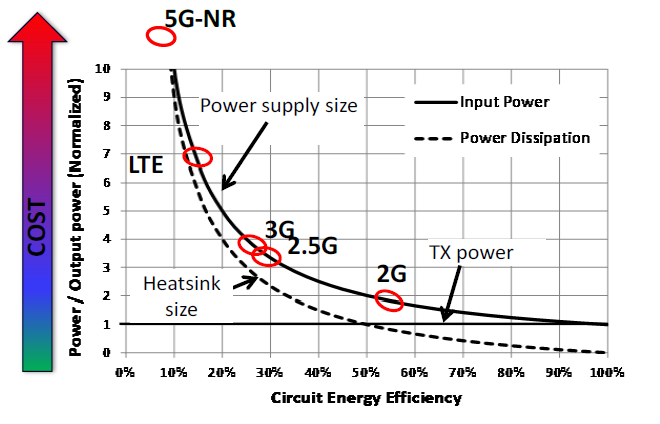The 5G network must be profitable to manufacture, install, and operate. To do this, 5G must achieve a more global optimization within the constraints of spectrum, energy, and money than both 4G-Long Term Evolution (LTE) and the current introduction to 5G-New Radio (NR). Optimization has more recently favored maximizing the data transfer capacity at the expense of power efficiency. This article focuses on the current energy constraint of 5G.

Knowing that the radio access network (RAN) is dominantly based on the 4G-LTE signal type, we can extend a decade of experience with respect to the LTE networks power draw to predict how much electric power will be needed if the 5G network gets deployed at full scale and operates at its then capacity. This extension showcases that there is not enough power on our planet now to operate such a network.
Utilizing the linear circuit theory, each cellular generation has increased modulation PAPR (peak-to-average power ratio), which unfortunately means each generation’s linear transmitters are less and less efficient, as seen in the figure above.

For a 20% efficient circuit, the manufacturer must provide an associated power supply that is 5x larger than the maximum output power that the transmitter can provide, and 80% of that power is transferred into the required heatsink. At 10% circuit efficiency, power supply is 10x larger and 90% is dumped into the heatsink. This characteristic has been tolerated so far, given that the size of the cellular network was small enough that this cost could be absorbed.
Now, the network has grown to the point that its power draw is several percent of total worldwide electricity generation capacity, putting this infrastructure on par with the energy draw of the entire aviation transport industry. At the present 46% compound annual growth rate of the data carried through the cellular network, it will draw half of all worldwide available electricity in 7 more years and all of it in 9 years. This falling efficiency and accompanied increased power consumption can no longer be ignored. It means massive increases in capital expenditures (capex) to provide and maintain the necessary power supply.
The Eridan MIRACLE RFFE module rewrites the cost equation for 5G by covering a square kilometer with 100Mbps with 5-10x less power and without a specialized power source. More information, including the original paper, can be found here.